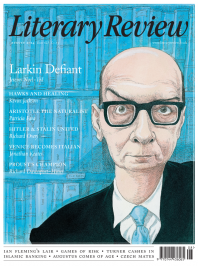Alex Danchev
Band of Bohemians
In Montmartre: Picasso, Matisse and Modernism in Paris 1900–1910
By Sue Roe
Fig Tree 365pp £20
‘On or about December 1910,’ according to Virginia Woolf, ‘human character changed.’ Modernism took hold. December 1910 is the terminus ad quem of Sue Roe’s history, which seeks to argue that ‘the real revolution in the arts first took place not, as is commonly supposed, in the 1920s, to the accompaniment of the Charleston, black jazz and mint juleps, but more quietly and intimately, in the shadow of the windmills – artificial and real – and in the cafés and cabarets of Montmartre during the first decade of the twentieth century’. If this sounds a little forced, it is possibly also a little hackneyed. ‘The unknown artists who gathered there and lived closely overlapping lives are now household names,’ Roe concludes in the introduction, breathlessly. ‘This book tells their story.’
In other words, In Montmartre bids to be a sequel to The Private Lives of the Impressionists (2006), Roe’s account of the modernists’ predecessors. That book was much admired for its lightness of touch. In fact it had both lightness and sureness; a canter and a conspectus, it seemed to

Sign Up to our newsletter
Receive free articles, highlights from the archive, news, details of prizes, and much more.@Lit_Review
Follow Literary Review on Twitter
Twitter Feed
It wasn’t until 1825 that Pepys’s diary became available for the first time. How it was eventually decrypted and published is a story of subterfuge and duplicity.
Kate Loveman tells the tale.
Kate Loveman - Publishing Pepys
Kate Loveman: Publishing Pepys
literaryreview.co.uk
Arthur Christopher Benson was a pillar of the Edwardian establishment. He was supremely well connected. As his newly published diaries reveal, he was also riotously indiscreet.
Piers Brendon compares Benson’s journals to others from the 20th century.
Piers Brendon - Land of Dopes & Tories
Piers Brendon: Land of Dopes & Tories - The Benson Diaries: Selections from the Diary of Arthur Christopher Benson by Eamon Duffy & Ronald Hyam (edd)
literaryreview.co.uk
Of the siblings Gwen and Augustus John, it is Augustus who has commanded most attention from collectors and connoisseurs.
Was he really the finer artist, asks Tanya Harrod, or is it time Gwen emerged from her brother’s shadow?
Tanya Harrod - Cut from the Same Canvas
Tanya Harrod: Cut from the Same Canvas - Artists, Siblings, Visionaries: The Lives and Loves of Gwen and Augustus John by Judith Mackrell
literaryreview.co.uk